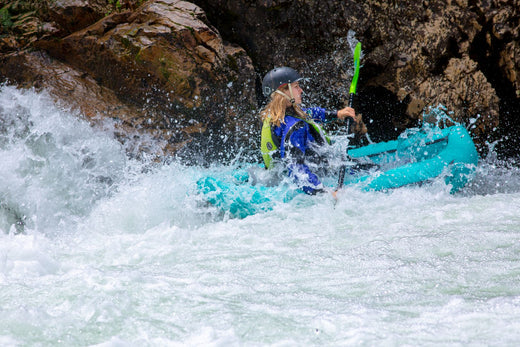Whitewater Raft Buying Guide: Choosing the Right Raft
September 10, 2024

Ready to take on some whitewater rafting? We've got you covered. Our extensive experience in the sport means we have a thorough understanding of what makes a good whitewater raft.
Whether you're a novice paddler starting in Class I waters or an experienced rafter planning for Class IV excitement, our whitewater raft buying guide is here to help you navigate buying your first craft.

Whitewater Raft Buying Guide: The Basics
When determining which type of whitewater raft is right for you, you must consider three key factors: shape, size, and material.
Raft Shape
The shape of your raft directly influences its performance, stability, and suitability for different activities. Round boats are the most versatile, offering strength and adaptability for paddle and oar setups. Their buoyant, symmetrical design allows them to handle various water conditions, from calm rivers to moderate rapids, making them a top choice for beginners and experienced rafters.
Meanwhile, catarafts are designed to perform well in challenging whitewater. Their twin-hull design easily cuts through waves, providing superior speed and maneuverability. While they don't offer quite the same passenger/gear combo rafts do, and they can't switch between being oar boats and paddle boats, they can be very versatile setups depending on what you're looking for. They don't necessarily require more experience than an oar raft. Still, they will handle things differently than a raft and require slightly different skill sets.
Paddlecats excel in technical sections where precise maneuvers are necessary. These playful and elegant rafts are a favorite for thrill-seekers, though they lack the broader utility of roundabouts.
Raft Size
The size of your raft can dramatically affect your experience. Smaller rafts, typically 9.5 to 13 feet, are highly maneuverable, making them ideal for day trips or navigating technical river sections where agility is essential. These rafts are easier to handle in tighter spots. They are often the vessel of choice for those who enjoy solo or small-group excursions.
Conversely, more giant rafts (14 to 18 feet) are better suited for carrying gear and passengers on longer trips or tackling more immense, mighty waters. These rafts offer excellent stability, which is crucial when loaded with equipment for a multi-day expedition or navigating larger rivers with significant waves.
A raft of at least 13 feet is best for multi-day trips, especially on expansive rivers. This ensures ample space for all your essentials without compromising maneuverability.
Raft Material
The material your raft is made of significantly impacts its durability and cost. Rafts made from synthetic rubber, such as Hypalon or Pennel-Orca, are renowned for their durability and resistance to abrasion.
These materials are particularly beneficial in rocky rivers or challenging conditions where the raft's outer shell is likely to encounter wear and tear. While these rafts come at a higher cost, their longevity often justifies the investment, especially for avid rafters who spend considerable time on the water.
Nowadays, many rafts are PVC-based, offering a good balance between performance and price. AIRE rafts, in particular, offer one of the best warranties available.
Advantages of Different Raft Types
Rafts: Versatility
Rafts are often the go-to choice for many rafters due to their versatility. They perform well in various water conditions, from gentle streams to moderate rapids, and are suitable for paddle and oar configurations. This flexibility makes them ideal for rafters who want a craft that can adapt to different environments and uses.
Whether tackling whitewater, embarking on a scenic float, or navigating mixed conditions, a raft offers the stability and ease of maneuverability that can make your experience more enjoyable and less stressful, especially if you're new to the sport.
Catarafts: High Performance
Catarafts are an excellent option for a high-performance craft designed for challenging whitewater. Their twin-hull design offers exceptional speed and precision without the weight and drag of a floor, allowing you to navigate complex rapids with greater control. This makes catarafts appealing to experienced rafters who thrive in demanding conditions and seek the thrill of cutting through powerful waves.
While catarafts don't necessarily require more skill to operate effectively, they do perform differently than rafts. They can be much more forgiving on some runs, although they have operational challenges to be aware of.
Paddlecats: Playfulness and Precision
Paddlecats offer a unique blend of playfulness and precision. These highly maneuverable rafts are designed to ride high on the water, making them a joy to paddle through technical sections and steep drops. Their lightweight structure allows for quick turns and responsive handling. It is ideal for rafters who enjoy a more dynamic, hands-on experience on the river.
However, like catarafts, paddle cats are more specialized and best suited for shorter, more playful runs rather than long expeditions or carrying heavy loads. While they may lack the broader utility of roundabouts, their agility and fun factor make them a favorite among thrill-seekers looking to master technical rapids.
Self-Bailing Floors
Regarding raft floor types, self-bailing floors are highly recommended for whitewater adventures. These rafts feature an inflated floor and drain holes that allow water to flow out, making them safer and more practical in turbulent conditions.
This design is particularly advantageous when navigating rough waters where splashing is inevitable, as it prevents water from accumulating inside the raft. With a self-bailing floor, you can focus on steering and enjoying the ride rather than worrying about manually removing excess water, which can be both time-consuming and exhausting.

How Do You Plan to Use Your Raft?
Identifying your raft's primary purpose is crucial to making the right choice. Whether you plan to use it for whitewater adventures, fishing trips, or family outings, your raft should be tailored to your primary activities.
For example, if fishing is your primary focus, a raft equipped with a specialized fishing frame and anchor system will provide the stability and convenience you need. A more giant, stable raft with plenty of seating and gear storage may be more appropriate for family outings, ensuring a safe and enjoyable experience for everyone on board.
Impact of Frame Design
The frame on your raft plays a role in the quality of your experience on the water. A fishing frame, for instance, offers better spacing and an integrated anchor system, making it easier to cast and reel in your catch without disturbing the raft's balance.
For more extended expeditions, an expedition cargo frame is essential for carrying all the necessary gear, including coolers and dry boxes to hold food, camping supplies, and safety equipment. This ensures your raft can handle the load without compromising performance, providing a stable and secure platform for your adventure.
Your Raft Buying Budget: Final Thoughts
When investing in a whitewater raft, it's essential to consider both the initial cost and the long-term value. High-quality rafts made from tough, wear-resistant materials might cost more upfront but offer superior durability and longevity. They are designed to withstand rough conditions and frequent use, making them a worthwhile investment if you spend much time on the water.
On the other hand, rafts made of less expensive materials might be more suitable if you're newer to the sport or expect to upgrade. While the initial cost may be lower, these rafts may require more frequent repairs or replacements, which could add up over time.
Other factors beyond the quality/denier of the raft materials that will impact your budget include whether or not you need self-bailing floors or more specialized designs. Also, ask yourself where you will be paddling — rafts for fishing trips on calm rivers don't require nearly the durability (and cost) of their more dedicated and robust whitewater cousins.
Frequently Asked Questions
What are some factors to consider when buying a whitewater raft?
When buying a new raft, consider factors such as the reputation and reviews of the brand and its retailer, the warranty included, and the company's customer support. Additional aspects may include durability, handling, performance, and where to use the raft. Also, consider where and how much you'll be using it. Even within a quality brand's line, it will offer boats at different prices, depending on the features and durability needed.
Are rafts designed for specific waters?
Yes, rafts are designed with specific waters in mind. Smaller, agile rafts offer better maneuverability and are ideal for technical rivers with tight turns and obstacles. More giant rafts are better suited for high-flow, mighty waters like those in the Grand Canyon, providing more excellent stability and capacity for gear. The shape also matters—rafts are versatile for various conditions. At the same time, catarafts and paddlecats excel in challenging whitewater due to their precision and speed.
What is the significance of the boat's shape, size, and material?
The shape determines how the raft handles different water conditions—rafts offer versatility, catarafts provide high performance in challenging rapids, and paddle cats excel in bringing the advantages of cataraft design to paddle boating. Size affects maneuverability and capacity, with smaller rafts being more agile and larger ones better for carrying gear on bigger waters. Material impacts durability and cost; Hypalon and Pennel-Orca are durable and UV-resistant but expensive, while PVC is more affordable but less durable.
How do you decide on your first raft?
Consider your intended boating types and outdoor adventures when choosing your first raft. The raft's suitability to specific water types and durability and performance features should also factor into your decision.
Is owning a raft affordable?
While the initial costs of getting into rafting can be high due to new equipment like helmets, rafting oars or paddles, and life jackets, it's possible to find a high-quality raft suited to your budget. Time your purchase to coincide with the retailer's sales or other specials. Research beforehand to ensure you make the right choice and will feel confident in your purchase.

